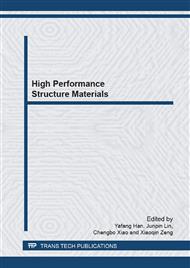p.594
p.604
p.613
p.619
p.625
p.629
p.636
p.641
p.647
Influence of Withdrawal Rate on Tensile and Stress Rupture Properties of the Single Crystal Superalloy DD9
Abstract:
The third generation single crystal superalloy DD9 was processed with different withdrawal rates and the effect of withdrawal rate on the tensile and stress rupture properties of the alloy was investigated. The relation between the mechanical properties and microstructure of the alloy with different withdrawal rates was discussed. The results showed that the withdrawal rate had a little effect on the tensile properties at 25 of the alloy. The tensile strength at 980 and stress rupture life at 1120/140MPa of DD9 alloy all increased with the increasing of withdrawal rate. The γ precipitates of specimen tensile at 25 had a little extension in the stress orientation. The extension of γ precipitates in the stress orientation at 980 was much more than that at 25. The vertical γ matrix at 980 became thinner and horizontal γ matrix became thicker slightly. The γ precipitates of those had rafted in a direction transverse to the applied stress.
Info:
Periodical:
Pages:
625-628
Citation:
Online since:
February 2013
Authors:
Keywords:
Price:
Сopyright:
© 2013 Trans Tech Publications Ltd. All Rights Reserved
Share:
Citation:


